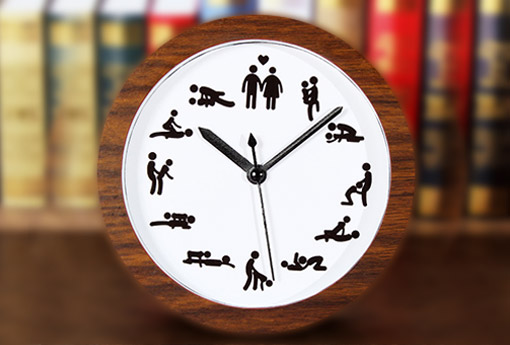Basic Information
Chinese name: safety period
Foreign name: Rhythm
Applied subjects: gynecology, sex education applicable
Areas of Field: Sex Education, Safety Education, Women
Commonly used safety period calculation methods include calendar method, basal body temperature measurement method, vaginal secretion observation method, ovulation tester monitoring method, etc. The combination of the above safety period calculation methods can effectively improve the contraceptive effect.
Introduction
Women of normal childbearing age have menstruation once a month, from the beginning of this menstrual cramp to the first day of the next menstrual cramp, called a menstrual cycle. Considering contraception, each menstrual cycle of women can be divided into menstrual period, ovulation period and safe period. Rhythm contraception is a method of contraception that stops sex during ovulation. This is a traditional contraceptive method, which was one of the most commonly used contraceptive methods at home and abroad before the birth of contraceptive pills and intrauterine devices. A woman's ovulation date is usually about 14 days before her next period. After the egg is released from the ovary, it can survive in the fallopian tube for 1-2 days to wait for fertilization; the sperm of a man can maintain its vitality in the reproductive tract of a woman for 2-3 days, so it is easy to conceive during intercourse in the days before and after the release of the egg. To be on the safe side, we call the first 5 days and 4 days after the ovulation day, together with the ovulation day, a total of 10 days as the ovulation period. Because sexual intercourse during ovulation is easy to conceive, the ovulation period is also known as the fertile period or the risk period.
specific
The safe period is divided into the safe period before ovulation and the safe period after ovulation. The period from the day of clear menstruation to the day before ovulation begins is the safe period before ovulation. The post-ovulation safe period is from the first day after the end of ovulation to the day before the next menstrual cramp. In general, the post-ovulation safe period is safer than the pre-ovulation safe period. This is because some women are sometimes affected by environmental changes and mood swings to advance ovulation, so that the pre-ovulation safe period will be shortened, and they do not know it, so the pre-ovulation safe period is not very safe. The chance of the ovary ovulating twice in a menstrual cycle is very rare, that is, the second ovulation will generally not occur during the period after ovulation and before the next menstrual cramp. Therefore, the post-ovulation safety period is relatively safe.
The key to using rhythm contraception is to determine a woman's ovulation date. When ovulation occurs, there is generally no special feeling. Although some women may have symptoms such as lower abdominal pain, backache, breast swelling and emotional changes, these phenomena are not unique symptoms of ovulation, so they cannot be used as the basis for ovulation. Menstruation and ovulation are cyclical changes, and there is a close relationship between the two. If you master the changing laws of the two, you can use an indirect method to determine the date of ovulation. There are many ways to determine the date of ovulation, and the methods that women can master by themselves include: calculating according to the menstrual cycle, measuring basal body temperature, and observing cervical mucus secretion.
calculation method
The following 3 methods teach you how to choose the safe period correctly.
calendar method
If the menstrual cycle is always accurate, ovulation may be on the 14th day after the menstrual cramps. After the egg cells are released, they can survive for about 2-5 days, and the sperm can survive for 1-3 days after entering the female reproductive tract. Therefore, 3-4 days before the ovulation period Days and 5-7 days after ovulation can prevent pregnancy. A woman with a regular menstrual cycle has a stable ovulation time. Sexual intercourse during the rhythm to achieve the purpose of contraception is called rhythm contraception. This method is not suitable for young people, because the frequency of their sexual intercourse is unlikely to be separated by a week or so. This method is suitable for middle-aged people.
Basal body temperature
Basal body temperature refers to the body temperature of a healthy person after waking up in the morning, generally it is the lowest body temperature in a day. In women of normal reproductive age, body temperature rises immediately after ovulation and continues until the start of the next menstrual cycle. Use the changing pattern of a woman's basal body temperature to find her ovulation period and abstain from intercourse 3-4 days before and 5-7 days after it.
vaginal discharge observation
Women's vaginal discharge changes regularly with the different phases of the menstrual cycle. During ovulation, there is more and more mucus, there is a wet feeling in the vagina, the mucus becomes clear, the mucus can be drawn, and the longest can reach 10 cm. The last day this mucus persists is usually around ovulation. No sexual intercourse for 3-4 days before and 5-7 days after.
Rhythm sexual intercourse is suitable for people with normal menstrual cycles, couples who often live together, and who can master and strictly observe the safety period; couples who do not often live together, women after childbirth or miscarriage, mental mood, living environment and health Women whose circumstances have changed, women who cannot grasp the safe period, and newlyweds who are emotional and have a strong sexual desire are not suitable for safe contraception for the time being.
Breastfeeding and Safe Period
Some people think that there is no menstrual period after childbirth, no pregnancy, and no need to take contraceptive measures. This understanding is incomplete. Because the recovery time of postpartum ovarian function varies from person to person, in general, if you don’t breastfeed after giving birth, your menstrual cramps often come 28-42 days after giving birth, and some menstruation will resume in about 3 months. Most of the first menstruation is more than usual, and most of them do not ovulate. A few people who do not breastfeed also occasionally ovulate. After 2-3 menstrual cycles after childbirth, the vast majority of women have complete recovery of ovarian function, normal menstrual flow, and ovulation.
Although there is no menstrual period during breastfeeding, ovulation still occurs, so some mothers can also get pregnant during breastfeeding. In some women, when the ovary has just resumed ovulation function and the first ovulation, the released egg cells soon encounter sperm and become fertilized eggs. All this shows that it is wrong to say that the so-called breastfeeding period of confinement is a "safe period". Breastfeeding women have the opportunity to receive milk no matter whether they have resumed menstruation or not. Therefore, breastfeeding women must be contraceptive after resuming their sexual life. , so as not to cause unnecessary trouble.
Pregnancy during lactation is very detrimental to maternal health. The trauma of childbirth has not yet recovered, and it is of course a painful and physically damaging thing to get pregnant or have an abortion. In particular, the scarred uterus (multi-fingered uterine scar after cesarean section) not only affects the recovery of the uterus, but also the mother bears the dual responsibility of breastfeeding and raising the fetus, which will inevitably lead to the consequences of malnutrition and anemia. Therefore, postpartum can not be negligent, must take contraceptive measures.
Postpartum contraceptive methods can be carried out in different stages: no sex within 56 days after delivery; contraceptive methods such as condoms, vaginal diaphragms, and external ejaculation should be used within 3 months after delivery to avoid and prevent sperm from entering the vagina and achieve contraception. Objective: After 3 months postpartum, an intrauterine device, commonly known as Lepu, should be placed. For caesarean section, the contraceptive device should be placed more than half a year after delivery; for postpartum patients with vaginal and pelvic infections, the time of placing the contraceptive device should be determined under the guidance of a doctor. Placing an intrauterine device is a safe, effective, simple and economical birth control measure, and it is still possible to get pregnant after removing the device, so it is very popular among women. 10 months postpartum, birth control pills can also be used.
contraception
natural contraception
In the first half of the menstrual cycle, the egg develops in the ovary, which mainly secretes estrogen, which thickens the lining of the uterus (endometrium), cervix and vagina, and enlarges the breasts. Then comes ovulation. The follicles in the ovary release mature eggs, which are manifested by an increase in basal body temperature and changes in cervical mucus. At this time, the follicles mainly secrete progesterone; ovulation is the "fertile period". If the egg is not fertilized, progesterone decreases and causes the lining of the uterus to shed and menstruation occurs. Natural contraception, also known as rhythm contraception or cyclical abstinence; refers to a means of preventing pregnancy by avoiding sex during the "fertile period" of each menstrual cycle.
Menstrual period contraception is only suitable for couples with regular menstrual cycles, long-term cohabitation, regular life, and mutual cooperation and understanding between both parties. However, based on its low safety, women who use this method of contraception should pay attention to the following points:
(1) Many diseases can change the ovulation time of women, such as endocrine diseases, kidney diseases, etc. Contraceptive failure can often result if the "safe period" is used during this period:
(2) Menstrual intercourse generally does not lead to pregnancy, but there is the possibility of accidental ovulation during menstruation, and menstrual intercourse is likely to cause infection, which is harmful but not beneficial;
(3) If it is a woman of menopausal age, when there is still a small amount of vaginal bleeding, you should have intercourse on the fourth day after the bleeding stops, because this bleeding may be caused by an ovulation;
(4) If you are switching from oral contraceptives to menstrual contraceptives, additional ovulation or irregular menstruation may occur in the first few months after stopping contraceptives, so these months should be as safe as possible period contraception.
Finally, we would like to remind all female friends that "rhythm" contraception is not all safe and is not worth advocating. Please choose a better contraceptive method according to your specific situation. After all, a contraceptive failure will bring you serious physical and mental trauma.
Condom, condom "condom" is really not easy.
Condoms are one of the conventional forms of contraception, and you may think that using condoms is as simple as putting on a hat
Safe period, as effective as body armor. However, according to the latest survey on World Contraception Day in 2012, even among those who have had sexual experience, 39% do not understand the correct use of condoms. On the premise that every sex is correct and used throughout the whole process, the contraceptive efficiency of condoms is about 85% to 98%, but sometimes the film is not particularly reliable. There is a risk of rupture. And if you don't read the instructions carefully and misuse the condom in a perfunctory manner, it will be less effective. Many people don't like the feel of a diaphragm and there are better contraceptive options available, but if you're having intimate contact with a non-regular partner, condoms are still recommended to prevent the spread of disease.
Breastfeeding contraception
The "king of endocrine" in the human body - the pituitary gland is controlled by the "supervisor" the hypothalamus. When the baby sucks on the nipple, the hypothalamus is reflexively inhibited, thereby inhibiting ovulation. If the baby sucks the nipple less, or the mother is affected by environmental changes, climate changes, emotional changes and sexual life, it is likely to affect ovarian ovulation through the cerebral cortex. Because ovulation comes first and menstruation comes later, some women may become pregnant before the menstrual period, commonly known as "undercover". According to surveys, 5% to 10% of women are inexplicably conceived during breastfeeding. Postpartum contraception is generally advisable to use condoms and birth control rings, and contraceptives should not be taken, so as not to affect the nursing baby.
menopause contraception
Women who are in menopause think that they have few menstrual periods, that they are close to menopause, and that there will be no chance of pregnancy, so they give up contraceptive measures. However, according to the statistics of the obstetrics and gynecology department of some hospitals, among all age groups, the 40-45-year-old is the highest, followed by the 20-24-year-old group. The reason for this is that when women reach menopause, although ovarian function declines and the secretion of estrogen and progesterone decreases, the ovaries may still ovulate and pregnancy may still be possible. Relevant data show that due to unhealthy ovum aging, menopausal women are pregnant, and the incidence of moles is 4 to 7 times higher than that of women of childbearing age, and there are many malignant transformations (malignant moles or choriocarcinoma). In this regard, menopausal women should also adhere to contraception until 1 to 2 years after menopause.
menstrual cycle estimate ovulation
Calculation method
The method of predicting ovulation according to the menstrual cycle is also known as the calendar method. Both menstruation and ovulation are affected by the pituitary gland and ovary's endocrine hormones and show cyclical changes. The length of the two cycles is the same, one cycle per month, and ovulation occurs in the middle of two menstruation. Women's menstrual cycles are long or short, but the interval between the day of ovulation and the start of the next menstrual period is relatively fixed, generally around 14 days. According to this relationship between ovulation and menstruation, the ovulation period can be estimated according to the menstrual cycle. The calculation method is to count from the 1st day of the next menstrual cramp, count down 14 days or subtract 14 days is the ovulation day, and the ovulation day and the 5 days before and 4 days after it are added together as the ovulation period. This is the theoretical basis of the rhythm contraceptive method. For example, if a woman's menstrual cycle is 28 days, the first day of this menstrual cramp is on December 2, then the next menstrual cramp will be on December 30 (December 2 plus 28 days), and then from December 30 days minus 14 days, then December 16 is the day of ovulation. The day of ovulation and the 5 days before and 4 days after it, that is, December 11-20 is the ovulation period. Except for the menstrual period and ovulation period, the rest of the time is safe. Sexual intercourse during the rhythm period does not require the use of any contraceptives and contraceptives.
Using this method to calculate the ovulation period, you must first know the length of the menstrual cycle, in order to calculate the start date and ovulation period of the next menstrual cramps, so it can only be applied to women whose menstrual cycle has always been normal. For women with irregular menstrual cycles, it is impossible to predict the date of the next menstrual cramp. Therefore, the ovulation day and ovulation period cannot be estimated.
statistical results
Contraception using the calendar method is prone to failure. Because some women sometimes delay or advance ovulation due to health conditions, environmental changes and mood swings, the ovulation period calculated according to the menstrual cycle is not accurate enough.
According to foreign statistics, the failure rate of using calendar method of contraception is 14.4%-47%. Therefore, this method is only suitable for people who have normal menstrual cycles, live together for a long time, and can correctly grasp the estimated safe period. This method is unreliable for people with irregular menstrual cycles, visiting couples, and women with changing life circumstances.
Safe period contraception needs attention
Rhythm contraception is a physiological contraceptive method. Sexual life is carried out in a normal state, and you can get satisfactory sexiness. However, if you cannot strictly master it or use it improperly, it will easily lead to failure.
The use of rhythm contraception must first accurately determine the ovulation period. The three methods currently used to determine the ovulation period have their own advantages and disadvantages: the calendar method can be used to estimate the ovulation period and the safe period before and after ovulation. However, it is only suitable for women with normal menstruation, and sometimes ovulation is advanced or delayed due to environmental changes and emotional changes, so it is not accurate enough; the measurement of basal body temperature can determine the date of ovulation and the safe period after ovulation, but the safe period before ovulation cannot be determined in advance. The method is more troublesome and requires strict requirements. If the body temperature is not measured according to the regulations, the date of ovulation cannot be accurately determined; the cervical mucus observation method can determine the ovulation period and the safe period before and after ovulation, which is more accurate, but the user must be trained. , can only be used after complete mastery. If these three methods are used in combination, they can make use of their strengths and avoid weaknesses, and achieve greater results.
At least one of the couples can master the method of determining the ovulation period. If they cannot master this method, they cannot use the rhythm contraception.
Rhythm contraception is to stop sexual intercourse during ovulation, which requires the close cooperation of the man, otherwise it cannot be used. Of course, you can also use external contraceptives during ovulation.
Reasons for rhythm contraceptive failure
1. It may be during menstrual intercourse, which generally does not lead to pregnancy, but there is also the possibility of accidental ovulation during menstruation, and menstrual intercourse is likely to cause infection, which is harmful but not beneficial;
2. Certain diseases of the body can cause changes in the time of ovulation in women. Such as endocrine disease, kidney disease and so on. At this time, the "safe date" calculated before becomes no longer safe;
3. If you take contraceptive pills before taking the contraceptive during the menstrual period, there may be additional ovulation or menstrual disorders in the first few months after the drug is stopped, which will affect the accuracy of calculating the safe period. Avoid menstrual contraception.








